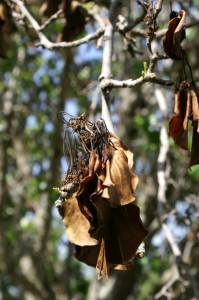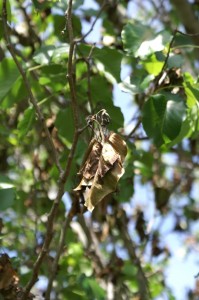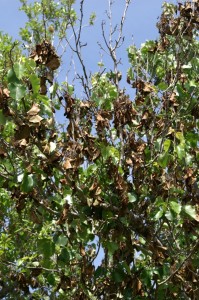DOWNLOAD PDF (PLPA-119) Fireblight on pears.
 The casual agent of fire blight is a bacterium– Erwinia amylovora, which causes a vascular wilt in many varieties of pome trees: apples, pears, and ornamental pears, such as Bradford pears planted in many landscapes.
The casual agent of fire blight is a bacterium– Erwinia amylovora, which causes a vascular wilt in many varieties of pome trees: apples, pears, and ornamental pears, such as Bradford pears planted in many landscapes.
Symptoms:
- Water-soaked flowers
- Leaves progressively turning brown and black blotches; curling and eventually shriveling
- Twigs begin to wilt from tip downward, turning black and curl in a classical “Sheperd’s hook”
- Branches develop dark, sunken cankers; as they enlarge and girdle the branches, the branch eventually dies.
Disease Cycle:

- The bacteria over-winters in cankers, bud scars and branches.
- Bacteria forms ooze which attracts insects and the insects then spread the bacteria via the nectarthodes in the flowers.
- The bacteria can also be spread by splashing rain.
- The bacteria can infect leaves and new tender succulent twigs.

Control:
 Sanitation pruning during winter dormancy – Cut an infected branch 8 to 12 inches below the visible injury or canker. To avoid spreading bacteria during pruning, sanitize the
Sanitation pruning during winter dormancy – Cut an infected branch 8 to 12 inches below the visible injury or canker. To avoid spreading bacteria during pruning, sanitize the- pruning tool before each cut with a 10% solution of bleach (one part bleach to nine parts water). To prevent rust, dry and oil tools after use.
- Reduce excessive succulence.
- Moderate resistant varieties are available.
- A weak (0.5%) Bordeaux mixture or other copper fungicide applied several times as blossoms open can reduce new infections, but will not eliminateall new infections or those already existing in wood.